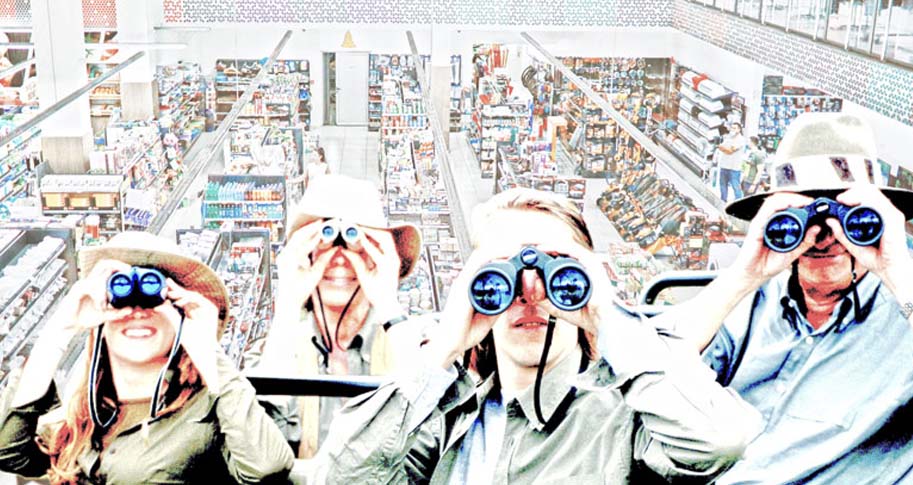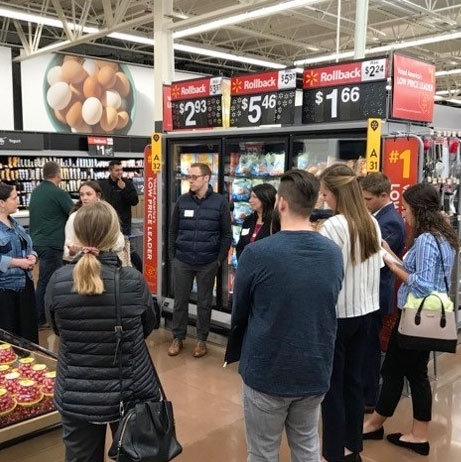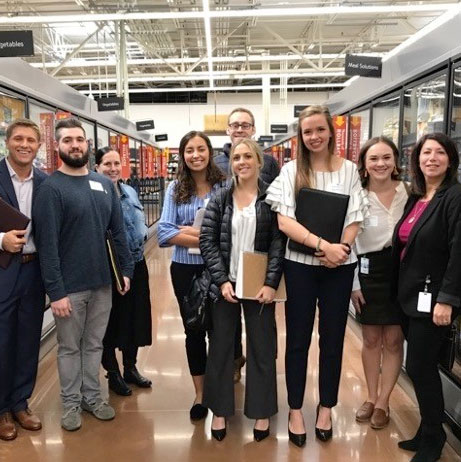
Walmart founder Sam Walton once said, “I probably have traveled and walked into more variety stores than anybody in America. I am just trying to get ideas, any kind of ideas that will help our company. Most of us don’t invent ideas. We take the best ideas from someone else.”
These store walks have long been a way for businesses to connect with consumers and watch as the plans of buyers and suppliers “come to life at the shelf.” This tradition continues under current Walmart CEO Doug McMillon. While it wouldn’t be unusual to see him and other company executives walking through Walmart’s flagship store in Bentonville, you may be surprised to see students walking with buyers and suppliers on a “Retail Safari” that brings to life what they’ve learned in class.
In their article “Retail Safari: Systematically Walking The Retail Store With Buyers And Suppliers” Molly Inhofe Rapert and Amaradri Mukherjee explore the benefits of a “retail safari” on a group of senior-level marketing students. These students strategically walked through a store with a group of executives, providing them with real-world experience that significantly enhanced what they learned in the classroom. The safari, built upon the notion of active, experiential and situated learning, proved to be a “quick but effective learning activity that reinforces content in a meaningful way while being easily adaptable to a variety of courses.”
Retail Safari: The Bridge Between Active, Experiential and Situated Learning
 To understand Retail Safari, we must first understand the types of learning it brings
together. Active learning is any activity that “involves students in doing things and thinking about things they are doing, rather than being passive recipients of information. Examples of active learning
include role-playing and group projects. Active learning enhances the retention of material and skills, positively impacting social integration
and institutional commitment.
To understand Retail Safari, we must first understand the types of learning it brings
together. Active learning is any activity that “involves students in doing things and thinking about things they are doing, rather than being passive recipients of information. Examples of active learning
include role-playing and group projects. Active learning enhances the retention of material and skills, positively impacting social integration
and institutional commitment.
Within the domain of active learning is experiential learning, “a process whereby knowledge is created through the transformation of experience.” Plenty of experiential learning methods have been implemented in marketing education, including study abroad, job shadowing and internships. Experiential learning facilitates student engagement and higher-order learning, improves classroom discussions and increases attendance in class.
Lastly, situated learning “specifically recognizes the value of learning spaces, affirming that learning occurs best when it is linked to the social situation to which it is applicable.” When participants working together have a shared interest, understand what is important to other people, and substantively interact with the community, learning is facilitated.
What makes a Retail Safari so effective is its combination of these three learning methods. On a Retail Safari, students are active participants in their learning, gaining real-world experience from industry professionals in a highly applicable environment within their community. “When combined in a Retail Safari, these three important strategies have the potential to galvanize the learning experience in a meaningful way.”
What Is the Retail Safari?
When you hear the word “safari,” you likely think of daring adventures such as trekking through the jungle or chasing big game in the African wilderness. While a Retail Safari isn’t quite as exciting, it does share much in common: “the chaos of achieving uncluttered stores and fully stocked shelves, the donning of professional clothing rather than casual classroom attire, interactions with accomplished executives who guide students through their jungle.” Students can learn about marketing techniques in the classroom, but when they step into a store and walk beside buyers and suppliers, they see the pertinence and utility of these techniques as never before. Furthermore, the knowledge provided by executives “adds a deeper meaning to concepts that had simply been words written in a book.”
Fittingly, the authors use the term guide as a framework for implementing a Retail Safari:
Gather Information
Identify key issues faculty and retail executives want to explore
Understanding
Clearly communicate to all partners the expectations of the project
Interaction
Provide a situated context within which students and executives will interact
Description
Identify specific aspects that students should describe post-activity
Evaluation
Evaluate the activity and revise as needed
They also provide three key elements that should be part of any Retail Safari:
- Prepare the students ahead of time with classroom discussions, research, and clear expectations
- Incorporate as many roles as possible related to the activity’s setting
- Close the loop with LinkedIn summary articles, student-developed glossaries of key terms, and debriefs
The author’s Retail Safari experiment and its findings are discussed below.
Methodology
 For their experiment, upper-level marketing students took part in a Retail Safari
at a mass merchandise retail store. This is because, given their proximity to Walmart,
most of these students seek positions related to this industry. Each group of students
walked the store alongside people with roles such as buyer, category analyst and
brand manager with a supporting agency. During the walkthrough, students discussed
concepts related to in-store marketing and merchandising while also evaluating the
store’s current marketing strategies. Afterwards, the students described their experience
and shared the best practices they were exposed to, as well as marketing efforts the
executives believed were underachieving.
For their experiment, upper-level marketing students took part in a Retail Safari
at a mass merchandise retail store. This is because, given their proximity to Walmart,
most of these students seek positions related to this industry. Each group of students
walked the store alongside people with roles such as buyer, category analyst and
brand manager with a supporting agency. During the walkthrough, students discussed
concepts related to in-store marketing and merchandising while also evaluating the
store’s current marketing strategies. Afterwards, the students described their experience
and shared the best practices they were exposed to, as well as marketing efforts the
executives believed were underachieving.
While these students completed the Retail Safari in the final weeks of their course, another group of students served as the control group and learned only in a traditional course environment. At the end of the course, these two methods were evaluated based on students’ overall satisfaction, and their rating of the methods’ perceived impact (e.g., preparation for the real world, knowledge gained, skills developed) and perceived value (e.g., relevance, usefulness, timeliness).
Findings
The authors found that students who took part in the Retail Safari were much more satisfied with the course than those who didn’t. Students who took part in the Retail Safari were also significantly more likely to recommend the course, and rated the course’s relevance, usefulness, and timeliness of content significantly higher than the control group. “Retail Safari,” the authors observe, “was also evaluated significantly higher in terms of preparation, knowledge gained, and skills developed.”
Conclusion and Discussion

An important challenge for marketing education is “delivering on the students’ desire for an interactive and interesting course while producing a higher level of marketing consciousness.” Thankfully, the authors found that a Retail Safari can do just that, as students who took part in one were far more satisfied and likely to recommend their course than those who didn’t.
The Retail Safari provides students valuable experience, enhances their knowledge, and is even a great source of talking points for future interviews. Faculty can also benefit from these safaris by interacting with executives and gaining cutting-edge information they can share in the classroom.
Retail Safaris afford students tangible, firsthand insight into the real-world operations of what they study in the classroom. As the authors write, “In an era where the business world is fluid and competitive, this novel activity should prove to be useful in combining theoretical learnings with active, experiential, situated learning applications. Extending the student experience beyond the classroom enhances the students’ knowledge and understanding by seeing first-hand how their college experience will play out in the aisles and shelves of the retail world.’’
The #rapertmktg Retail Safari is sponsored by the northwest Arkansas chapter of the Network of Executive Women.






